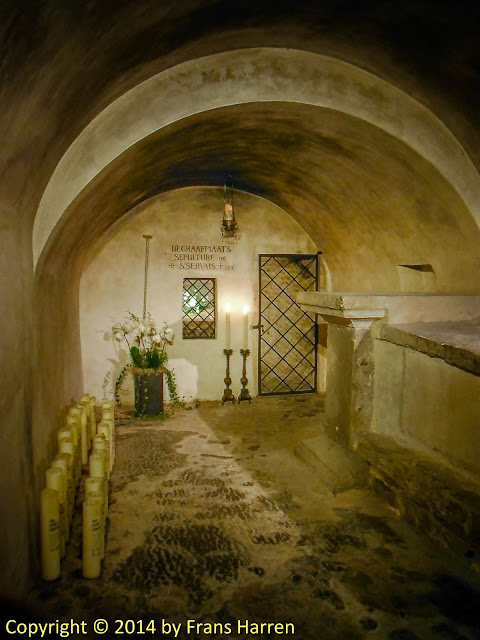
Basilica of Saint Servatius
The Basilica of Saint Servatius is a Roman catholic church dedicated to Saint Servatius, in the city of Maastricht, the Netherlands. The architecturally hybrid but mainly Romanesque church is situated next to the Gothic church of Saint John, facing the town's main square, Vrijthof.
History
The present-day church is probably the fourth church that was built on the site of the grave of Saint Servatius, an Armenian missionary who was bishop of Tongeren and died allegedly in 384 in Maastricht. A small memorial chapel on the saint's grave was replaced by a large stone church built by bishop Monulph around 570. This church was replaced by a larger pilgrim church in the late 7th century, which was then replaced by the present-day structure, which was built in several stages over a period of more than 100 years. The nave was built in the first half of the 11th century, the transept in the second half of the century, and the choir and westwork in the 12th century. The Romanesque church was built during a period in which the chapter of Saint Servatius kept close ties to the Holy Roman Emperors, which resulted in a building that has the characteristics of a German imperial church. The dedication of the church in 1039 was attended by the emperor Henry III and twelve bishops. Most of the church's Medieval provosts were sons of the highest ranking German noble families. Several held the office of chancellor of the German Empire; at least eight provosts went on to become archbishops.
The sculpted Bergportaal, at the south side of the church, was begun around 1180 and can be considered late Romanesque or early Gothic. All the chapels along the side aisles are Gothic {14th and 15th centuries), and so is the vaulted ceiling of the nave and the transept. In 1556 a late Gothic spire was added onto the westwork between the two existing towers. In 1770 the entire westwork was crowned with Baroque helmet spires, designed by the Liège architect Etienne Fayen.
Over the centuries the interior of the church underwent many changes. In the 17th century, the Gothic choir rood screen with sculpted depictions of the life of Servatius was demolished. Fragments from the 14th-century screen were discovered during the 1980s restoration works and are now kept in the church's lapidarium in the East crypt. By the end of the 18th century, the entire church interior had been painted white, the colourful Medieval stained glass windows had been replaced by colourless glass, and the church looked distinctly Baroque.
In 1797 the chapter was dissolved by the French revolutionaries and the church was used as a horse stable by the troops. In 1804 the church became a parish church once again. It was during this period that irreparable damage was done to the church interior. For liturgical reasons, it was considered to be necessary to lower the elevated choir. The underlying 11th-century crypt was entirely demolished, most of the carved capitals were lost. Similarly, the main altar on which the reliquary chest of Saint Servatius with its accompanying panels had been displayed for many centuries, was demolished. Sadly, in 1846 the four panels that belonged to the reliquary chest were sold.
Between 1866 and 1900 the church underwent major restorations during which some of the damage done earlier in the century was reversed. The restoration was led by famous Dutch architect Pierre Cuypers. In 1955 a fire caused Cuypers' Gothic Revival westwork spire to fall through the roof of the church, which made another thorough restoration necessary (1982–1991). During this latter restoration, Cuypers' colourful interior decoration scheme was largely removed. During this most recent restoration, extensive excavations that were carried out in the church and adjacent buildings, revealed a wealth of information about the history of the church and its predecessors.
Religious significance
Through the ages, the presence of the grave of Saint Servatius in the church crypt and the many relics in the church treasury, have drawn large numbers of pilgrims. Starting in the 14th century (but perhaps earlier) a seven-yearly pilgrimage was organized in cooperation with nearby Aachen Cathedral and Kornelimünster Abbey, attracting tens of thousands of visitors to the region. This so-called Heiligdomsvaart continued until 1632 when Maastricht became affiliated with the Dutch Republic (Capture of Maastricht). The Heiligdomsvaart was revived in the 19th century and the tradition continues in our days. The next Heiligdomsvaart will take place in July 2018.
Today, the Basilica of Saint Servatius is the main church of the Deanery of Maastricht, which belongs to the Diocese of Roermond. The church continues to be a center of Catholicism in Maastricht (the other main church being the Basilica of Our Lady). The church was made a Basilica Minor by Pope John Paul II during his visit in 1985.
Art historical significance
Although the present building conveys a rather hybrid image of architectural styles, the church of Saint Servatius is considered to be one of the most important religious buildings in the former Prince-Bishopric of Liège. Both the East choir and the Westwork of the Maastricht church have been influential in the development of Romanesque architecture in the Meuse and Rhine valleys. Several authors have pointed out the significance of the South portal's late Romanesque sculpture for the early development of Gothic sculpture in France.
See: wikipedia











0 comments:
Post a Comment